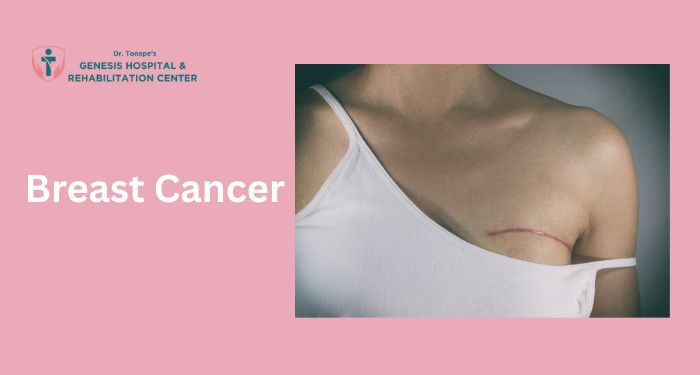Breast cancer remains one of the most common cancers affecting women worldwide. While it can be a life-threatening disease, the good news is that early detection, timely treatment, and increased awareness have significantly improved survival rates in recent years.
Understanding the symptoms, risk factors, and available treatments is essential for every woman—and for the people who care about them. In this article, we’ll walk through everything you need to know about breast cancer, when to see a breast cancer specialist, and how to take proactive steps for prevention and recovery.
What Is Breast Cancer?
Breast cancer occurs when cells in the breast begin to grow abnormally and form a tumor. This tumor can grow and invade surrounding tissues or even spread to other parts of the body (metastasis). It can begin in different parts of the breast, such as the milk ducts (ductal carcinoma) or the lobules (lobular carcinoma).
While breast cancer primarily affects women, it can also occur in men, though it is much rarer.
Common Signs and Symptoms
Recognizing the signs of breast cancer early can make a critical difference in treatment success. Watch for:
-
A lump or thickening in the breast or underarm
-
Change in the size or shape of the breast
-
Dimpling or puckering of the skin
-
Inverted nipple or change in the appearance of the nipple
-
Redness or scaling of the nipple or breast skin
-
Nipple discharge, especially if bloody
-
Persistent pain in one area of the breast
Not every lump is cancerous, but it’s always wise to have any changes evaluated by a doctor promptly.
Risk Factors for Breast Cancer
Several risk factors may increase your likelihood of developing breast cancer, including:
-
Age: Most cases occur in women over 50
-
Family history: Having a mother, sister, or daughter with breast cancer
-
Genetics: BRCA1 and BRCA2 gene mutations significantly increase risk
-
Hormonal factors: Early menstruation, late menopause, or hormone replacement therapy
-
Lifestyle factors: Obesity, alcohol consumption, sedentary lifestyle
-
Radiation exposure to the chest
-
Not breastfeeding or having children later in life
Understanding your personal risk can help guide screening and lifestyle decisions.
Diagnosis and Screening
The earlier breast cancer is detected, the more treatable it is. That’s why regular screenings are essential.
Common screening and diagnostic tests include:
-
Mammogram: X-ray of the breast, used for routine screening
-
Ultrasound: Often used to evaluate suspicious lumps
-
MRI: Offers detailed imaging, especially for high-risk patients
-
Biopsy: Confirms the presence of cancer by testing a tissue sample
-
Genetic testing: Identifies BRCA gene mutations for high-risk individuals
Most doctors recommend annual mammograms starting at age 40, or earlier for women with a family history of the disease.
Types of Breast Cancer
There are several types of breast cancer, each requiring a tailored treatment approach:
-
Ductal carcinoma in situ (DCIS) – Non-invasive, early-stage
-
Invasive ductal carcinoma (IDC) – Most common form, can spread
-
Invasive lobular carcinoma (ILC) – Begins in the lobules
-
Triple-negative breast cancer – Aggressive and harder to treat
-
HER2-positive breast cancer – Overexpression of HER2 protein, often fast-growing
A breast cancer specialist can determine the exact type and stage through imaging, biopsy, and lab tests.
Treatment Options
Treatment depends on the type, stage, and location of the cancer, as well as your overall health. Common treatments include:
1. Surgery
-
Lumpectomy: Removal of the tumor and a small margin of tissue
-
Mastectomy: Removal of one or both breasts, sometimes including lymph nodes
2. Radiation Therapy
Targets remaining cancer cells after surgery to reduce the risk of recurrence.
3. Chemotherapy
Uses drugs to destroy cancer cells, often used before or after surgery.
4. Hormone Therapy
Blocks hormones like estrogen that may be fueling cancer growth.
5. Targeted Therapy
Focuses on specific characteristics of cancer cells, such as HER2.
6. Immunotherapy
Helps the immune system recognize and fight cancer cells (used in certain advanced cases).
Every patient’s treatment plan is individualized. That’s why choosing the right breast cancer specialist with experience in personalized, multidisciplinary care is vital.
Emotional Support & Recovery
A breast cancer diagnosis can be emotionally overwhelming. Support from family, friends, counselors, and survivors’ groups can make a significant difference.
Consider:
-
Joining a breast cancer support group
-
Speaking with a mental health counselor
-
Practicing stress management techniques (yoga, meditation)
-
Eating a nutritious, healing-focused diet
-
Staying active as advised by your doctor
Recovery is not just physical—it’s emotional, too. Be gentle with yourself, and ask for help when you need it.
Prevention and Self-Care
While breast cancer cannot always be prevented, some steps can reduce your risk:
-
Maintain a healthy weight
-
Exercise regularly
-
Limit alcohol intake
-
Eat a diet rich in fruits, vegetables, and whole grains
-
Perform regular breast self-exams
-
Get clinical breast exams and mammograms as recommended
Conclusion
Breast cancer is a serious condition, but with early detection, effective treatment, and emotional support, many women lead long, healthy lives after diagnosis. Regular screenings, awareness of symptoms, and maintaining a healthy lifestyle are your best tools in fighting this disease.
If you or a loved one notices unusual symptoms or has a family history of breast cancer, don’t delay seeking expert help. A skilled breast cancer specialist can guide you through diagnosis, treatment, and recovery with compassion and expertise.

